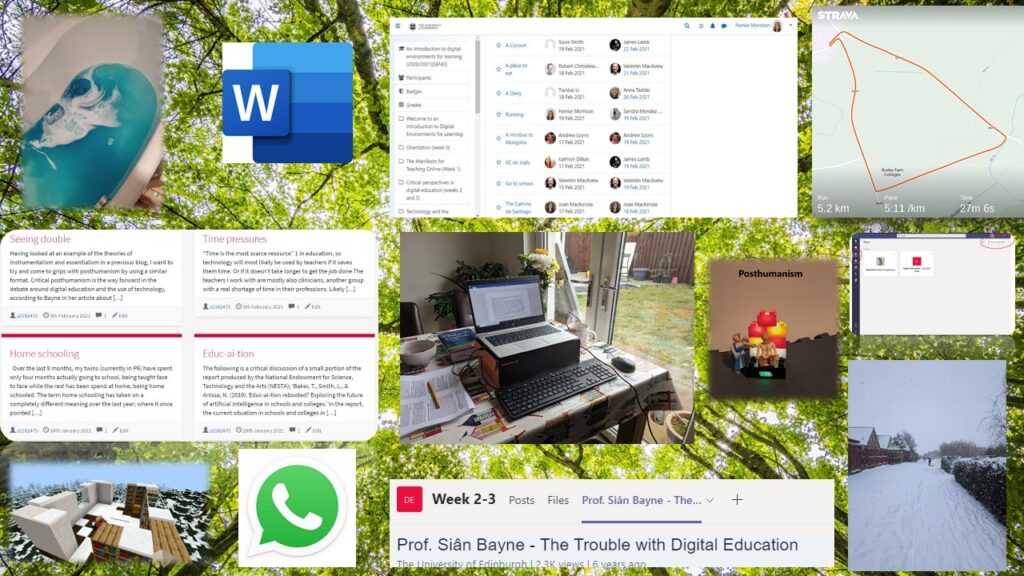IDEL Learning spaces
We were asked to make an image that represents the IDEL learning space and I have chosen to make a collage with different pictures to represent the spaces that I am learning in during this course. One of the most interesting things about this, is how many spaces there are that are a significant part of my learning and how flexibly I have been using several spaces to achieve learning.

Borrowing a phrase from one your comments, I think my most formal learning space is in the middle of the collage, it feels like the hub that the learning takes place in and around. Still, it is actually our dining room table and as such, not a traditionally formal space at all. This space can still be described as fluid (Bayne et al. 2014), since it also functions as a dining space, home schooling space for my kids, craft table and many other functions besides. It is also in many ways the family hub in our house. This is where I usually put my laptop though and write (as I am doing now) as well as read the articles, forums etc.
You could argue though, that while I am sitting physically at my dining room table in my own house, I am simultaneously present digitally, when I look and contribute to the IDEL forums or write a blog. But equally when I communicate with fellow students using MS Teams or WhatsApp. (as pictured). The digital and physical spaces that I inhabit definitely overlap and are connected rather than opposed (Mulcahy 2018). I think especially for a course like IDEL, which you essentially undertake in physical solitude (from other students and a teacher), the digital interaction is a necessity to learning. It is through conversations with others, whether your fellow students or your blog / forum tutors that you can work towards new ideas and develop the knowledge that you gain when you read the articles provided.
Where the learning takes place using ‘other’, meaning non-human (Bayne 2015), mediums like Minecraft or even toys (here pictured as my three story treehouse and my photo depicting posthumanism) an interaction can take place between the human and the other. In the case of Minecraft, the type of building I choose for the learning space was influenced by the options in the game. At the same time, having a certain set of options available to me whilst designing the learning space, made me think about learning spaces in new ways. In the same fashion, when I was first coming to grips with the theories of posthumanism, transhumanism, essentialism and instrumentalism, creating a model of them using Lego and Play Mobil helped me think about the theories in a certain way that was influenced by the form and use of the other.
Looking at my less formal learning spaces, where the learning isn’t always expected, I have shown these in the collage as a walk in the snow, a picture of one of my runs using Strava and the picture of a bath. These are more private spaces you could say, but the learning process still leaks into these areas. Sometimes the learning does take place deliberately in these spaces as well; when I head out after reading an article, I often think about what I have read or learned because I have the time and space to do so. Rather than staying seated at my dining room table, I choose to go out and find space and quiet around me to process, similar to a student choosing a cubby hole to study in. (Mulcahy 2018)
I have tried to use pictures in the collage to show all the different ways and places that are important for my interaction with IDEL. It is very interesting to see how IDEL seems to be present in so many different places and spaces in my life.
Bayne, S., Gallagher, M.S., & Lamb, J. (2014). Being ‘at’ university: the social topologies of distance students. Higher Education, 67(5), pp. 569-583.
Sian Bayne (2015) What’s the matter with ‘technology-enhanced learning’? Learning, Media and Technology, 40:1, 5-20, DOI: 10.1080/17439884.2014.915851
Mulcahy, D. (2018). Assembling Spaces of Learning ‘In’ Museums and Schools: A Practice-Based Sociomaterial. In Ellis, R.A. & Goodyear, P. (Eds.). Spaces of Teaching and Learning: Integrating Perspectives on Research and Practice (pp13-30). Singapore: Springer.




I like that idea of the physical stable place that is also a material and digitally fluid space. Your use of lego/ play mobil and Minecraft are nicely linked together as objects for thinking with about the (somewhat abstract) theories and concepts we’re exploring in this course. Your comments on walks and runs being important but informal spaces of learning are important – is this where much of the quality thinking time that is necessary as discussed in Sheail (2018) and so you have a space for learning activities (the dining room table) and spaces for reflective learning (running/ walking/ the bath…).
The collage and your discussion work well together with a light-touch but very effective use the literature from this block.